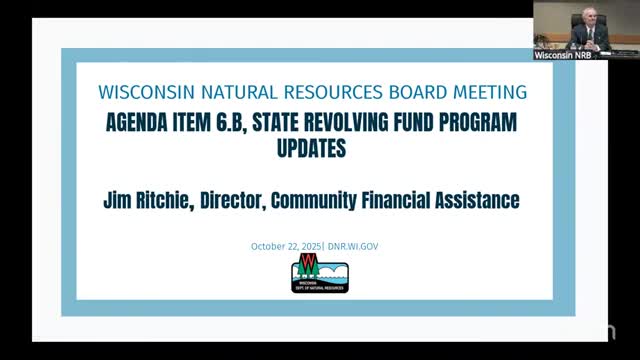DNR details nearly $1 billion in federal SRF funding and community loan outcomes
October 23, 2025 | Department of Natural Resources, Executive Departments, Executive, Wisconsin
This article was created by AI summarizing key points discussed. AI makes mistakes, so for full details and context, please refer to the video of the full meeting. Please report any errors so we can fix them. Report an error »

The Department of Natural Resources briefed the Natural Resources Board on the State Revolving Fund (SRF) programs on Oct. 22, describing substantial federal funding under the bipartisan infrastructure law and the program's role financing drinking-water, wastewater and stormwater projects across Wisconsin.
Program basics: Jim Ritchie, director of the Bureau of Community Financial Assistance, said the SRF is made up of two loan programs—the Clean Water Fund and the Safe Drinking Water Loan Program—providing low-interest loans, principal-forgiveness and long-term repayment to municipalities for treatment facilities, sewer work, stormwater projects, PFAS treatment and lead-service-line replacement.
Federal infusion: Ritchie said the bipartisan infrastructure law provides five additional yearly capitalization grants (2023–2027) that add approximately $193.4 million per year to the state programs, totaling roughly $967 million over five years for supplemental capital and targeted PFAS and lead-service-line funding.
Financial mechanics and examples: Ritchie noted the market interest rate set quarterly by the state is 4.7 percent; the SRF standard subsidized rate (55% of market) is about 2.585 percent. For a representative $3.8 million project over 20 years, the department calculated borrowers would save roughly $1 million in interest versus paying the market rate. Ritchie gave examples: a regionalization sanitary-sewer project for Burnett Sanitary District; South Milwaukee's multi-year lead-service-line replacement efforts (the city celebrated its 1,000th removal this summer); and West Bend's PFAS-treatment installation funded partly by SRF principal forgiveness.
Distribution and equity: Ritchie said SRF awards in recent years reached communities large and small, with projects awarded statewide. He said only eight counties had not received SRF-funded projects in the past three years and described pilot project authority that can fund nontraditional green-infrastructure projects, such as a $28 million green-infrastructure package for Milwaukee Metropolitan Sewerage District.
Next steps and demand: demand for loans and principal forgiveness has averaged about $900 million per year in recent years, Ritchie said, driven by the new federal funding and state needs. He noted the federal lead-and-copper rule gives communities until February 2037 to replace all lead service lines, which the department said will require funding beyond the federal infusion.
Program basics: Jim Ritchie, director of the Bureau of Community Financial Assistance, said the SRF is made up of two loan programs—the Clean Water Fund and the Safe Drinking Water Loan Program—providing low-interest loans, principal-forgiveness and long-term repayment to municipalities for treatment facilities, sewer work, stormwater projects, PFAS treatment and lead-service-line replacement.
Federal infusion: Ritchie said the bipartisan infrastructure law provides five additional yearly capitalization grants (2023–2027) that add approximately $193.4 million per year to the state programs, totaling roughly $967 million over five years for supplemental capital and targeted PFAS and lead-service-line funding.
Financial mechanics and examples: Ritchie noted the market interest rate set quarterly by the state is 4.7 percent; the SRF standard subsidized rate (55% of market) is about 2.585 percent. For a representative $3.8 million project over 20 years, the department calculated borrowers would save roughly $1 million in interest versus paying the market rate. Ritchie gave examples: a regionalization sanitary-sewer project for Burnett Sanitary District; South Milwaukee's multi-year lead-service-line replacement efforts (the city celebrated its 1,000th removal this summer); and West Bend's PFAS-treatment installation funded partly by SRF principal forgiveness.
Distribution and equity: Ritchie said SRF awards in recent years reached communities large and small, with projects awarded statewide. He said only eight counties had not received SRF-funded projects in the past three years and described pilot project authority that can fund nontraditional green-infrastructure projects, such as a $28 million green-infrastructure package for Milwaukee Metropolitan Sewerage District.
Next steps and demand: demand for loans and principal forgiveness has averaged about $900 million per year in recent years, Ritchie said, driven by the new federal funding and state needs. He noted the federal lead-and-copper rule gives communities until February 2037 to replace all lead service lines, which the department said will require funding beyond the federal infusion.
View full meeting
This article is based on a recent meeting—watch the full video and explore the complete transcript for deeper insights into the discussion.
View full meeting
